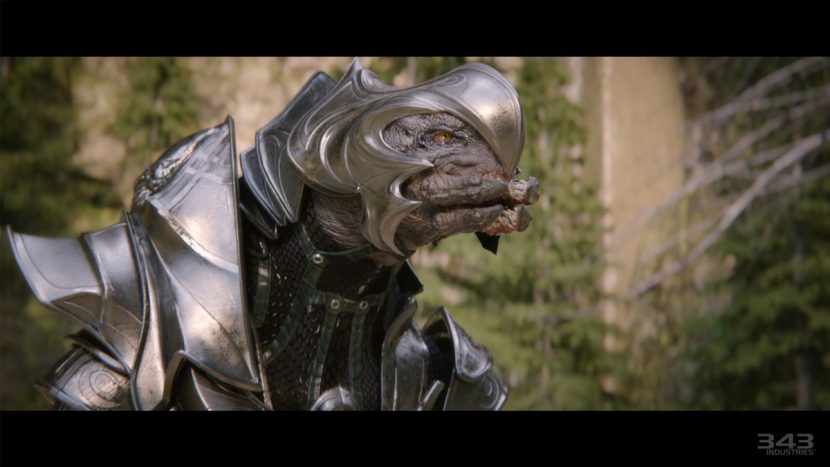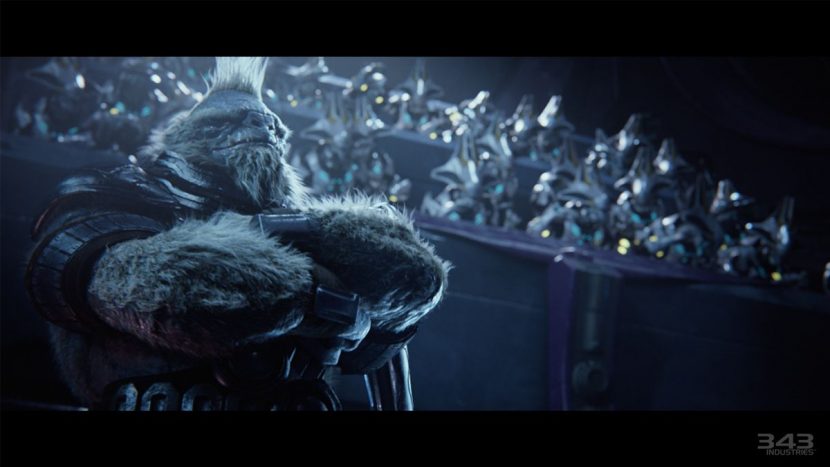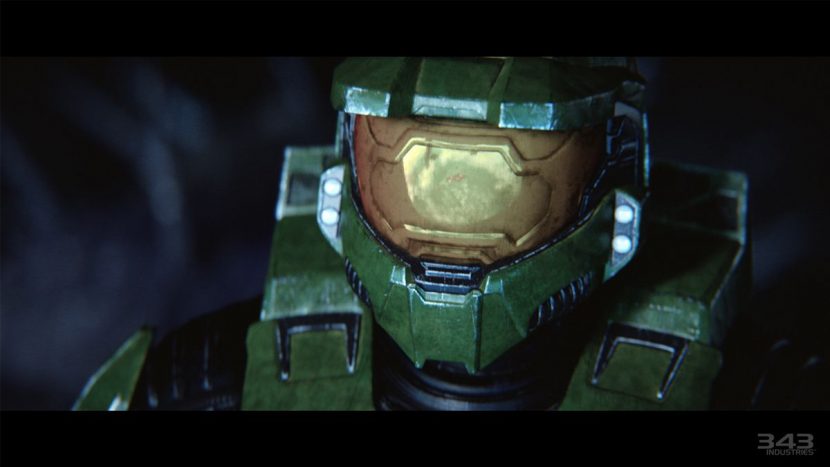When Microsoft Studios released Halo 2: Anniversary, a remastered version of Halo 2 with additional content, remastered audio and graphics, they did so with the help of more than 50 minutes of rendered cinematics from Blur Studio. We talk to director Franck Balson and CG supervisor Jerome Denjean about making those cinematics possible.
– Above: watch the trailer for Halo 2: Anniversary.
fxg: It must have been somewhat of a daunting project at 56 minutes long – where did you start on this?
Balson (director): Well, we started in January this year and had to be done in September. We had a pretty good idea of the running time because the existing cinematic was closing in on 56 minutes – we had to work out how to get 56 minutes through our pipeline and make it as good as we could. We were expecting to get all the concept art, but there weren’t many concepts done then. So we had to re-concept all of the characters, all of the environments, and up-res everything. Then we had to re-model the characters to give them a higher fidelity. The biggest challenge was the time we had to do everything. We started in January this year and had to be done in September.
Jed Denjean (CG supervisor): This project was actually a little peculiar because we were tasked with re-doing the cinematics that came out with the game 10 years ago. So we already had a pretty good idea of what was needed because they wanted us to up the ante of graphics and visual quality. The cinematics themselves were pretty much set, so we had a nice blueprint to get started. Overall, Blur took the assets and spiced up the action.
fxg: You had the original cinematics, but did you have the original animation files or assets to work with?
Balson: Microsoft was great about sharing with us anything and everything they had. The first thing we did was look at everything Bungie had made and try to extract as much as we could. Say, their environments, but we couldn’t really re-use anything they’d done before. At the time they’d done everything in-game, meaning they had one cinematic – it was like one big Maya file – with all the environments scrambled, one to the right, one to the left, and one camera, and it would basically jump between two frames to the other side of the environment and the two characters would also pop to the other side.
And it was also previously done with all keyframe, using the game engine and the game assets. So really the only thing it helped us with was the broad style. But it became apparent that we were going to have to re-imagine and re-work the cinematographic part of it. We took the story and the pre-existing audio – that didn’t change really. And the running time couldn’t change because the old and new versions had to work together. But within those constraints we could do whatever we wanted as long as it told the same story or improved on it.
Denjean: When you actually play the game, you can push one button and flip between the cinematics from ten years ago and the newer stuff. So that’s why they wanted to keep the running times very similar. People might be watching the ‘legacy’ cinematics if they’re nostalgic about back in the day. And someone else might be looking at the new ones, and they wanted to make sure people would be done at the same time.
– Watch a side by side of the cinematics.
fxg: Because you had access to the old cinematics, but your current techniques are really pushing photorealism, did you feel like you had to cut back on any of the techniques you were using to do rendering, say?
Balson: Originally the whole thing was, hey why don’t we just make it look better. Not even trying to re-think the whole cinematography of it. But then when we looked at it, we thought we couldn’t live with ourselves and only make the image better and not change the way it was told, because there is so much cool stuff that could be done. So then we had to make something that looks cool but also plays nicely having those constraints – using the audio, the running time, using the same amount of shots but trying to do it differently. On the technical side, we had to switch a few things in order to meet the deadlines.
fxg: Was there a mocap shoot?
Balson: Yes, but usually we do a lot of heavy action pieces – this one was kind of the opposite, where we pretty much had 45 minutes of dialogue with photoreal humans and creatures. There were a couple of scenes just with action. In order to be able to go through those total 56 minutes of animation, we had to have a strategy. We’ve been using mocap for a long time, so we basically used mocap for all the human characters and all the bipedal creatures such as the Arbiters, the Brutes. Some of the only characters that were keyframed from scratch were the Grunts, those dwarf-looking, half-snail creatures – they’re kind of like the comic relief characters in the game.
We actually spent 21 days in mocap with stunt performers. Because we had a lot of dialogue, we basically re-edited the original cinematics to get the dialogue to flow the way we wanted, without paying attention to the action that was happening. We would bring that to the shoot and say, OK the action is supposed to be this – you go to point A, turn around and come back to point B and do this. So we had our actors match the vocal that was playing at the same time in the background. That was a very different exercise for them because they had to give the character a specific intention that might be different from the delivery of the line but still fit with the timing of the delivery. It was a lot of re-dos to match the timing as close as possible. After that we were going to have to do facial motion capture with MOVA, where you have a person sitting in a chair and it’s like a realtime face scan of their actions.
fxg: What was your mocap pipeline?
Balson: We shot the mocap – everything is captured with Vicon. It gets cleaned, goes through Motion Builder and gets re-targeted to our bipedal rigs in Max. We do all our layout in Max and there we do an almost first-pass animation. All the mocap we get is cleaned final. In Max we do all the blends with Biped. Despite the fact that it’s a really old piece of software, it’s actually pretty robust and it’s very fast. You don’t have a lot of things to fuck around with and it just works. We blend all our clips with this and once the layout is done, we publish everything. We have tools that have been written in-house that export every single character as FBX. It goes back into Motion Builder and is re-targeted into our Softimage rigs, which are then polished and animated on top of. Once this animation pass is done, everything is point cached out to go back into 3ds Max for rendering, for cloth sims and hair.
– Watch this hour long documentary on Halo 2: Anniversary.
fxg: Can you identify one particular shot or sequence that you’re particularly proud of?
Balson: If you’re considering the timeframe and the deadline we had to work on, I’m proud of the whole thing. I think it’s some of the best facial animation work we’ve done. We approached it a little differently to what we usually do, and instead of splitting body and facial performance between two different performers, had the actors doing the mocap be the same person doing the facial work. The gimmicks a person does is something you don’t really think about. When they do it on stage, they will actually do it inside the MOVA shoot naturally. So it’s much easier for them to get the timing just right. We were really trying to get their eyelines as close as possible to the mocap shoot.
There’s a scene when the medals are being given. Lord Hood gives a medal to Miranda Keyes and she has this moment when she thinks about her dad. And there’s another one right at the end when Cortana is looking at the camera and says ‘Shoot’ and the eyes and the motion of the lips and everything is just like looking at a video – it’s so real.
Denjean: The character work was really a step up for us, whether it was the quality of the actors, the quality of the facial scans that we got. This is by far our best work, character-wise.
Balson: It was certainly a big challenge to have so many characters doing so much acting. Usually we get away with people just screaming and making pain faces. Here it was a whole different deal.
fxg: How much were you involved in other parts of the production, say sound design and editing?
Balson: We were involved from the get-go. Microsoft was one of the best clients. Just from a production stand-point, having a client that gives you feedback instantly, especially for such a big company, is frickin awesome. Especially for artists, because having someone sit idle waiting for a few days because we’re waiting for feedback. Whenever we were asking questions we’d get all the information we need – the day of.
We did a lot of concepts, so we were able to put a lot of our thoughts into the characters. Microsoft would basically be the gatekeepers, saying yes we like this idea or saying that’s going a little bit too far away from the actual canon of the game. We had a lot of freedom on that side.
We would always trying to make it cooler or more exciting or working out how to sell the moment better. They were super-flexible on a lot of stuff. I mean, we added a few fights here and there when the original one was just a head butt. And they were, totally, we want to make it as exciting as possible.
As far as editing, everything is done in-house. Whenever we do the layout, we do the temp track, we do the temp sound effects. The only thing that’s done outside the studio is the final music and the final sound. For this one, the sound was made at SOURCE SOUND. And the music was re-recorded at Skywalker Ranch. That was really one thing where they wanted to keep the original music scores. We tried to convince them to use some more dynamic music for some of the cinematics. I learnt during the course of the project that there is a huge Halo fan base, and if we changed the music they’d be coming out with sticks and putting our heads on it.
So aside from the music, everything is in-house. I think that’s why people love coming to Blur, because instead of just doing images, we deliver the whole piece done and ready to go.




Great article Ian, loved it.